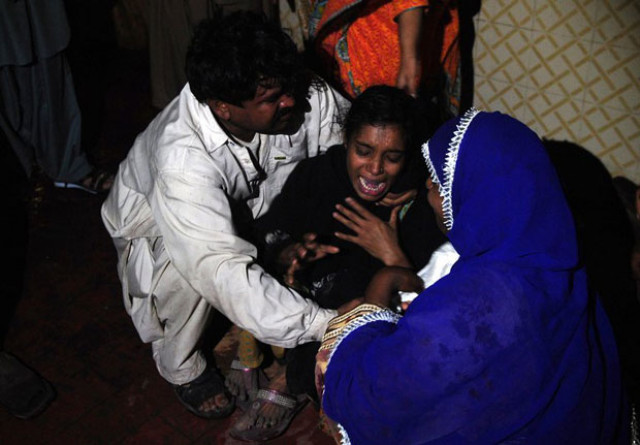The Civil Hospital Karachi was shadowed in a strange silence and gloom yesterday morning. Over fifty ambulances sprawled the space outside the morgue.
Every few minutes a siren blasted from round the corner, and another ambulance made its entry. As a group of anxious relatives surrounded the ambulance, no one spoke. Many families repeated the exercise, till suddenly a cry of horror would break cut the deadly silence like a knife. As each member of the family peeked inside the ambulance, their grief, shock and despair would give way to tears ─ they had identified their loved one ─ only that the victim no longer lives.
They too fell prey to one of the most tragic incident this city has witnessed. The fire broke in a textile factory on Hub River road and could not be controlled even after twelve hours of fire-fighting.
As the ambulances poured in with more dead bodies, there was no more space in the morgue. The burnt victims were left to be identified in the vehicles parked all over the hospital. Grieving families could be seen sitting in the corners wiping their tear-stained faces. Some fainted with the shock and were taken to the Emergency Department for treatment.
Every few minutes, the death toll rose. Even the Operation Theatre Complex elevator controller wiped a tear off as he updated me with the new death toll of over 200. Every single person in the hospital was affected by the incident.
The condition in which the victims’ bodies were brought was beyond belief. They were black, charred and in different physical state altogether that spoke volumes of their last attempts to escape their hell on earth. The families recognised them from left overs of their clothes, slippers, jewellery and even some National Identity Cards (NICs). As each grieved family recognised their dead loved one, they left in the ambulance along with them. Hundreds still stayed in the court yard of the Civil Hospital, waiting anxiously for news they did not want hear.
The fire that broke out in the textile factory in Baldia Town had engulfed the building within hours. It is reported to have broken out at 6pm when approximately over a thousand workers were present. The intensity and heat from the fire challenged the fire brigade as they continued to wrestle with it. They managed to save a only a few workers while the others either burned or suffocated to death.
This textile factory on Hub River road is alleged to have a single exit. There is absolutely no evidence of a fire escape, extinguishers or even safety protocols. The workers trapped inside could not escape from the raging flames and tried to huddle in the back of the building. Some of them jumped from the second and third floors to save their lives. According to reports, women and children were also employed at the factory and many died in this tragic incident.
The owners of this factory obviously did not expect a calamity of this nature. Even so, they did absolutely nothing to provide safety to their employees in the event of one occurring. Having access to a fire exit should have been a basic right of the workers. Sadly, fire extinguishers, smoke detectors and water sprinklers are considered a luxury in this part of the world.
This incident exposes the abhorrent condition of our industry in terms of protection of its workers from emergencies. Fire escapes and emergency warning systems should be a mandatory requirement before a factory is given license to operate. Moreover, fire safety drills should be conducted regularly - no room for argument here. The buildings should have a supply of fire detectors and fire extinguishers available at all times; this should be the rule for all work places regardless of the size or the people they employ.
This grave tragedy should be an eye-opener for all those other industries that do not provide basic rights to their employees.
In the end, those who were responsible for this fire and for the sealing of exits should be brought to justice and an example should made out of them.
[poll id="207"]
Read more by Jahanzeb here.
Join us on Facebook for blog updates and more!
Burned alive: Who is to blame?
Fire escapes and emergency warning systems should be a mandatory requirement before a factory is given their license.



COMMENTS
Comments are moderated and generally will be posted if they are on-topic and not abusive.
For more information, please see our Comments FAQ